曹工说Spring Boot源码(21)-- 为了让大家理解Spring Aop利器ProxyFactory,我已经拼了
写在前面的话
相关背景及资源:
曹工说Spring Boot源码(1)-- Bean Definition到底是什么,附spring思维导图分享
曹工说Spring Boot源码(2)-- Bean Definition到底是什么,咱们对着接口,逐个方法讲解
曹工说Spring Boot源码(3)-- 手动注册Bean Definition不比游戏好玩吗,我们来试一下
曹工说Spring Boot源码(4)-- 我是怎么自定义ApplicationContext,从json文件读取bean definition的?
曹工说Spring Boot源码(5)-- 怎么从properties文件读取bean
曹工说Spring Boot源码(6)-- Spring怎么从xml文件里解析bean的
曹工说Spring Boot源码(7)-- Spring解析xml文件,到底从中得到了什么(上)
曹工说Spring Boot源码(8)-- Spring解析xml文件,到底从中得到了什么(util命名空间)
曹工说Spring Boot源码(9)-- Spring解析xml文件,到底从中得到了什么(context命名空间上)
曹工说Spring Boot源码(10)-- Spring解析xml文件,到底从中得到了什么(context:annotation-config 解析)
曹工说Spring Boot源码(11)-- context:component-scan,你真的会用吗(这次来说说它的奇技淫巧)
曹工说Spring Boot源码(12)-- Spring解析xml文件,到底从中得到了什么(context:component-scan完整解析)
曹工说Spring Boot源码(13)-- AspectJ的运行时织入(Load-Time-Weaving),基本内容是讲清楚了(附源码)
曹工说Spring Boot源码(14)-- AspectJ的Load-Time-Weaving的两种实现方式细细讲解,以及怎么和Spring Instrumentation集成
曹工说Spring Boot源码(15)-- Spring从xml文件里到底得到了什么(context:load-time-weaver 完整解析)
曹工说Spring Boot源码(16)-- Spring从xml文件里到底得到了什么(aop:config完整解析【上】)
曹工说Spring Boot源码(17)-- Spring从xml文件里到底得到了什么(aop:config完整解析【中】)
曹工说Spring Boot源码(18)-- Spring AOP源码分析三部曲,终于快讲完了 (aop:config完整解析【下】)
曹工说Spring Boot源码(19)-- Spring 带给我们的工具利器,创建代理不用愁(ProxyFactory)
曹工说Spring Boot源码(20)-- 码网恢恢,疏而不漏,如何记录Spring RedisTemplate每次操作日志
工程结构图:

概要
前面两三篇,介绍了spring aop得以实现的利器:ProxyFactory。
ProxyFactory,全称:org.springframework.aop.framework.ProxyFactory,spring帝国spring aop军工厂boss,职责就是生产proxy,即,代理工厂。
通过下面几行代码,就能生成一个代理对象,而且我们还加了了一个环绕通知:
@Test
public void createJdkDynamicProxyWithAdvisor() {
ProxyFactory proxyFactory = new ProxyFactory();
Performer performer = new Performer();
proxyFactory.setTarget(performer);
proxyFactory.addInterface(Perform.class);
DefaultPointcutAdvisor advisor = new DefaultPointcutAdvisor();
advisor.setAdvice(new MethodInterceptor() {
@Override
public Object invoke(MethodInvocation invocation) throws Throwable {
Object result = invocation.proceed();
System.out.println("男孩唱完要行礼");
return result;
}
});
proxyFactory.addAdvisor(advisor);
Perform proxy = (Perform) proxyFactory.getProxy();
ProxyFactoryTest.log.info("proxy class:{}",proxy.getClass().getName());
proxy.sing();
}
输出如下:

本讲,我们来讲讲,背后的故事。
ProxyFactory如何构造
其一共有如下几个重载的构造函数:
- 无参构造函数
- ProxyFactory(Object target) 指定target
- ProxyFactory(Class[] proxyInterfaces) 指定代理类要实现的接口
- ProxyFactory(Class proxyInterface, Interceptor interceptor) 指定代理类要实现的接口,以及一个切面
- ProxyFactory(Class proxyInterface, TargetSource targetSource) 指定代理类要实现的接口,以及一个targetSource,targetSource类似于一个targetFactory,通过其,间接获取target
因为spring aop源码里,默认就使用了的是无参构造函数,这里我们也以无参构造函数来讲解。
我们知道,构造函数调用时,如果这个类有父类,还得先调用父类的构造函数。恰巧,这个类就有父类:

其中,ProxyConfig没有显示定义的构造函数,所以只有默认的无参构造函数。所以,
会先调用ProxyConfig的无参构造函数;
调用AdvisedSupport的无参构造函数,如下:
/**
* No-arg constructor for use as a JavaBean.
*/
public AdvisedSupport() {
initMethodCache();
}
/**
* Initialize the method cache.
*/
private void initMethodCache() {
this.methodCache = new ConcurrentHashMap<MethodCacheKey, List<Object>>(32);
}
接下来,调用ProxyCreatorSupport的无参构造函数:
/**
* Create a new ProxyCreatorSupport instance.
*/
public ProxyCreatorSupport() {
this.aopProxyFactory = new DefaultAopProxyFactory();
}
调用ProxyFactory的无参构造函数
/**
* Create a new ProxyFactory.
*/
public ProxyFactory() {
}
其中,比较有的讲的,主要是第三个步骤,即ProxyCreatorSupport的无参构造函数。
这一步呢,new了一个DefaultAopProxyFactory,不过,暂时还没用到它。
构造完了,接下来,就是各种配置上场的时候了。
配置ProxyFactory
好歹这也是一响当当的工厂,但是吧,要生产啥呢?总得有个方向吧。你是一个ProxyFactory,代理工厂,你要代理谁?代理卖火车票,还是代理卖房呢?注意,这里我说的是卖火车票,和卖房。
这说明啥,说明我屁股是坐在卖方的,是12306一方,是要卖房的一方。因为啥呢,因为我现在的target,是卖方,我是作为卖方的代表(即,代理)来出现的。
target很重要,这个直接决定了我们工厂的方向。比如,假设翻转一下,代理买方。比如,现在中国人,有钱人很多,很多人就去国外买房,比如澳洲、日本、东南亚啥的,但是呢,你对当地不了解,所以,就催生了当地的一批华人,来帮助大陆中国人在那边买房,此时,他们就是我们的代理。我们呢,就是他们的target。
ok,大家想必理解了,ProxyFactory要生产啥,主要还是要有个定位,看看屁股坐哪边。所以,我们作为代码世界的王者,就要负责来定方向。
配置target
Performer performer = new Performer();
proxyFactory.setTarget(performer);
定了target,基本定了一半了。
当然,你也不可以不直接定target,定接口也行。
配置接口,即代理要具备的功能
proxyFactory.addInterface(Perform.class);
配置额外的切面(可选)
DefaultPointcutAdvisor advisor = new DefaultPointcutAdvisor();
advisor.setAdvice(new MethodInterceptor() {
@Override
public Object invoke(MethodInvocation invocation) throws Throwable {
Object result = invocation.proceed();
Method method = invocation.getMethod();
if (method.getName().equals("sing")) {
System.out.println("男孩唱完要行礼");
}
return result;
}
});
proxyFactory.addAdvisor(advisor);
这个步骤是可选的,你也可以没有切面,没有的话,默认就是代理啥事都不帮你做,你让他帮你分析房产,结果人只收钱不干活。
我们这里的切面,是在target唱歌完了之后,输出一句话:要行礼。
额外的一些配置
当然了,作为一个齐备的工厂,还是要支持一些客户的定制功能的。比如:
从ProxyConfig继承来的一些方法
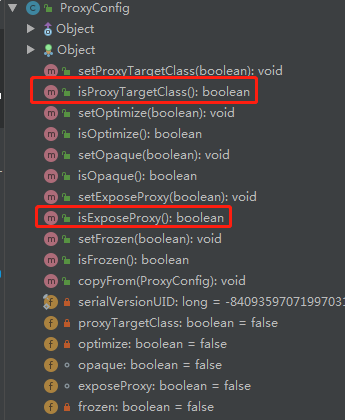
比如,有的客户说,我要cglib创建代理,有的说,我要jdk。ok,这个就满足你了。
再比如,isExposeProxy,这个可以把生成的代理通过一个api提供给你,你可以在target方法内,拿到代理对象。
从AdvisedSupport继承来的功能
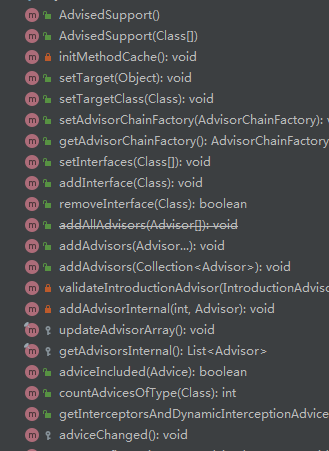
这个也简单,基本就是我们前面那几个配置的重载方法,增删改查嘛。
从ProxyCreatorSupport继承来的功能

这个嘛,基本就是扩展了一下,搞了点事件/监听的机制,方便我们扩展。
ok,配也配好了,是不是该把代理对象给人家了。
根据配置,生成代理
我写着写着,发现这个东西,很像开一个煎饼店,比如根据客户要求:要鸡蛋、培根、鸡排啥的(这个就是对应上面的配置部分);然后,这一步,我们作为店老板,就开始去根据客户的要求,煎煎饼!
Perform proxy = (Perform) proxyFactory.getProxy();
煎饼的过程如何,我们来看看:
public Object getProxy() {
return createAopProxy().getProxy();
}
是不是很简单,其实,我们应该分为两步来看:
public Object getProxy() {
/**
* AopProxy是一个接口,实现类有jdk动态代理、cglib两种
*/
AopProxy aopProxy = createAopProxy();
return aopProxy.getProxy();
}
选择客户要求,选择合适的煎锅
这一步,就是对应:
/**
* AopProxy是一个接口,实现类有jdk动态代理、cglib两种
*/
AopProxy aopProxy = createAopProxy();
因为我们这里,AopProxy有两种实现,要用哪一种,要根据之前的配置来,比如,指定了proxyTargetClass,那就是要用cglib;否则就用jdk 动态代理。
我们具体看看:
protected final synchronized AopProxy createAopProxy() {
if (!this.active) {
activate();
}
/**
* 其实这里获取的,就是之前构造函数时那个DefaultAopProxyFactory
*/
AopProxyFactory aopProxyFactory = getAopProxyFactory();
return aopProxyFactory.createAopProxy(this);
}
这里,先获取了AopProxyFactory,这里呢,拿到的,就是之前我们构造函数时候那个。
/**
* Return the AopProxyFactory that this ProxyConfig uses.
*/
public AopProxyFactory getAopProxyFactory() {
return this.aopProxyFactory;
}
这里拿到DefaultAopProxyFactory后,程序会调用其createAopProxy(this),且把当前对象都传进去了,当前对象是谁?就是ProxyFactory代理工厂本厂。
具体的创建代码如下:
public AopProxy createAopProxy(AdvisedSupport config) throws AopConfigException {
if (config.isOptimize() || config.isProxyTargetClass() || hasNoUserSuppliedProxyInterfaces(config)) {
Class targetClass = config.getTargetClass();
if (targetClass == null) {
throw new AopConfigException("TargetSource cannot determine target class: " +
"Either an interface or a target is required for proxy creation.");
}
if (targetClass.isInterface()) {
return new JdkDynamicAopProxy(config);
}
return CglibProxyFactory.createCglibProxy(config);
}
else {
return new JdkDynamicAopProxy(config);
}
}
注意看最上面的if判断:
if (config.isOptimize() || config.isProxyTargetClass() || hasNoUserSuppliedProxyInterfaces(config))
是不是,如果isProxyTargetClass为true,或者hasNoUserSuppliedProxyInterfaces,按里面理解,没有提供接口,则会走下面的逻辑,去用cglib创建代理。
因为我们这里是提供了接口的,所以,会new一个:jdk的动态代理。
public JdkDynamicAopProxy(AdvisedSupport config) throws AopConfigException {
Assert.notNull(config, "AdvisedSupport must not be null");
if (config.getAdvisors().length == 0 && config.getTargetSource() == AdvisedSupport.EMPTY_TARGET_SOURCE) {
throw new AopConfigException("No advisors and no TargetSource specified");
}
this.advised = config;
}
这里可以看到,构造函数很简单,就是把代理工厂本厂的引用传给他了。我们前面配了那么多东西在ProxyFactory上,怎么能说给人就给人?
废话,不给JdkDynamicAopProxy,它怎么创建代理呢?
JdkDynamicAopProxy揭秘
这个类,我直接给大家说,其实现了两个接口:
代理接口:AopProxy
public interface AopProxy { /**
* Create a new proxy object.
* <p>Uses the AopProxy's default class loader (if necessary for proxy creation):
* usually, the thread context class loader.
* @return the new proxy object (never {@code null})
* @see Thread#getContextClassLoader()
*/
Object getProxy();
}
这个接口就是获取代理对象。
java.lang.reflect.InvocationHandler接口
这个接口,熟悉jdk动态代理的就知道,拦截的逻辑就写在这里面。我们大概可以猜测,代理对象调用方法时,就会被拦截到这个方法里面来处理。
生成代理对象
前面,我们已经讲解了这一步了:
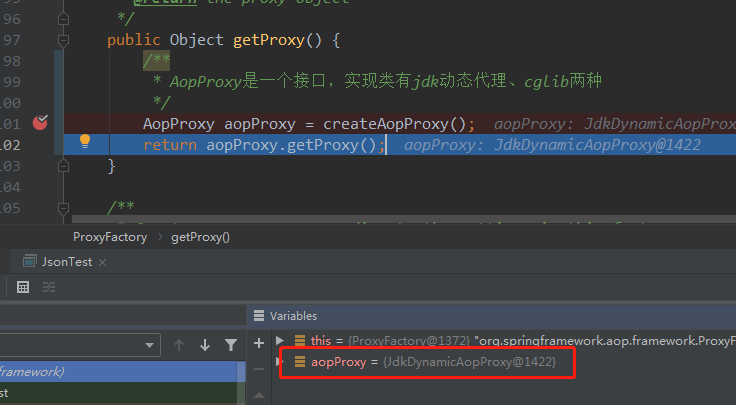
马上就要调用getProxy来生成代理对象。
org.springframework.aop.framework.JdkDynamicAopProxy#getProxy(java.lang.ClassLoader)
public Object getProxy(ClassLoader classLoader) {
if (logger.isDebugEnabled()) {
logger.debug("Creating JDK dynamic proxy: target source is " + this.advised.getTargetSource());
}
Class[] proxiedInterfaces = AopProxyUtils.completeProxiedInterfaces(this.advised);
findDefinedEqualsAndHashCodeMethods(proxiedInterfaces);
return Proxy.newProxyInstance(classLoader, proxiedInterfaces, this);
}
这里就简单的几步:
获取要代理的全部接口
Class[] proxiedInterfaces = AopProxyUtils.completeProxiedInterfaces(this.advised);
实际上,大家记得,我们前面只配了一个要代理的接口,但这个方法内部,还会给我们加上两个接口。
org.springframework.aop.SpringProxy
这个是marker接口,空的,不用管,只是做个标记,框架会用到
org.springframework.aop.framework.Advised

这个接口,功能比较全,还是一些增删改查的操作,对象吧,是那些切面、target啥的,这可以让我们动态地修改生成的代理对象。
调用jdk方法,生成代理
return Proxy.newProxyInstance(classLoader, proxiedInterfaces, this);
这里没啥说的,唯一就是,第三个参数,传了个this,这里的this,就是JdkDynamicAopProxy它自己。前面我们也说了,它自己实现了java.lang.reflect.InvocationHandler。
调用代理对象的方法时,如何作用
我们再想想代理的作用,不就是帮我们干点事吗?那要怎么帮我们target干事呢?
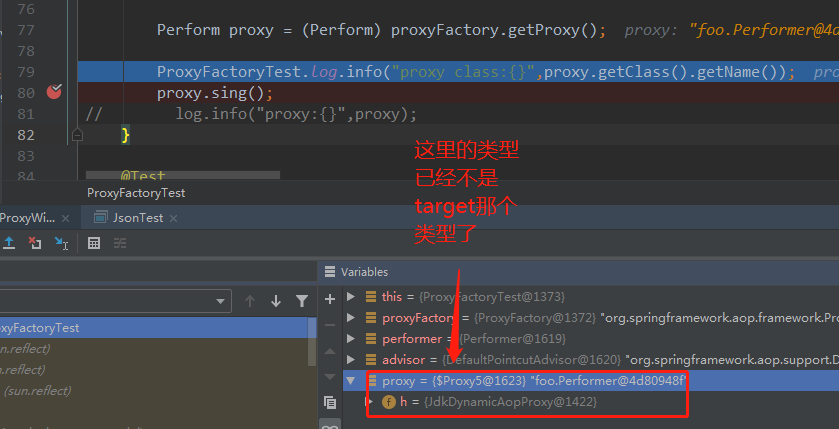
注意,当我们拿到ProxyFactory的getProxy返回的对象时,其类型已经有点奇怪,你看上图,它的类型是$Proxy5.
这是jdk动态生成的class。
所以,我们调用,实际上是在代理对象上进行调用,对他们进行调用,实际的逻辑会被跳转到之前生成代理时,传进去的那个invocationHandler对象的invoke里面去。
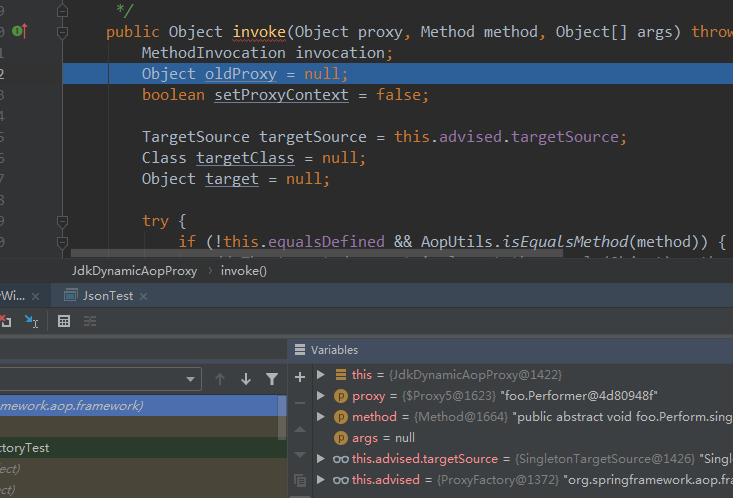
这个页面,熟悉吧,不用我多说了,但凡大家在service层加了事务,debug时,进去的就是这个地方。
方法的核心逻辑,大概如下:
Object retVal;
// 1. May be null. Get as late as possible to minimize the time we "own" the target,
// in case it comes from a pool.
target = targetSource.getTarget();
if (target != null) {
targetClass = target.getClass();
}
// 2. Get the interception chain for this method.
List<Object> chain = this.advised.getInterceptorsAndDynamicInterceptionAdvice(method, targetClass);
// Check whether we have any advice. If we don't, we can fallback on direct
// reflective invocation of the target, and avoid creating a MethodInvocation.
if (chain.isEmpty()) {
// 3. We can skip creating a MethodInvocation: just invoke the target directly
// Note that the final invoker must be an InvokerInterceptor so we know it does
// nothing but a reflective operation on the target, and no hot swapping or fancy proxying.
retVal = AopUtils.invokeJoinpointUsingReflection(target, method, args);
}
else {
// 4. We need to create a method invocation...
invocation = new ReflectiveMethodInvocation(proxy, target, method, args, targetClass, chain);
// Proceed to the joinpoint through the interceptor chain.
retVal = invocation.proceed();
}
上面的代码,我标了号。
第一处,是获取target,根据之前配置的targetSource来获取,忘了的可以再翻一下;
第二处,根据当前要执行的method和class,判断哪些切面(其实就是代理要帮我们做的事)是匹配的
第三处,如果切面集合为null,说明代理啥事不干,所以只能直接调用target了
retVal = AopUtils.invokeJoinpointUsingReflection(target, method, args);第四处,如果切面不为null,说明代理有事要做,这里就封装了一个invocation,来调用切面集合。
这里面有两点要讲,第二处和第四处。
第二处,获取匹配的切面时,核心逻辑是,把切面里的切点,和目标类、目标方法一一匹配,都匹配,就算;否则不算。
public List<Object> getInterceptorsAndDynamicInterceptionAdvice(
Advised config, Method method, Class targetClass) { // This is somewhat tricky... we have to process introductions first,
// but we need to preserve order in the ultimate list.
List<Object> interceptorList = new ArrayList<Object>(config.getAdvisors().length);
boolean hasIntroductions = hasMatchingIntroductions(config, targetClass);
AdvisorAdapterRegistry registry = GlobalAdvisorAdapterRegistry.getInstance();
// 讲解点1
for (Advisor advisor : config.getAdvisors()) {
if (advisor instanceof PointcutAdvisor) {
// Add it conditionally.
PointcutAdvisor pointcutAdvisor = (PointcutAdvisor) advisor;
// 讲解点2
if (config.isPreFiltered() || pointcutAdvisor.getPointcut().getClassFilter().matches(targetClass)) {
MethodInterceptor[] interceptors = registry.getInterceptors(advisor);
MethodMatcher mm = pointcutAdvisor.getPointcut().getMethodMatcher();
// 讲解点3
if (MethodMatchers.matches(mm, method, targetClass, hasIntroductions))
{
interceptorList.addAll(Arrays.asList(interceptors));
}
}
}
else {
Interceptor[] interceptors = registry.getInterceptors(advisor);
interceptorList.addAll(Arrays.asList(interceptors));
}
}
return interceptorList;
}
这里就三个讲解点,
- 1是遍历全部的切面
- 2是拿出切面中的切点的classMatcher,看看目标class是否匹配
- 3是拿出切面中的切点的methodMatcher,看看目标方法是否匹配
实际调用切面和目标方法
这里用到了责任链模式,递归执行;其实也可以直接for循环的。
这里new了一个ReflectiveMethodInvocation,这个其实就是一个wrapper,包裹了所有必要的参数,可以理解为大杂烩,主要是封装一下,代码不那么乱。
protected ReflectiveMethodInvocation(
Object proxy, Object target, Method method, Object[] arguments,
Class targetClass, List<Object> interceptorsAndDynamicMethodMatchers) { this.proxy = proxy;
this.target = target;
this.targetClass = targetClass;
this.method = BridgeMethodResolver.findBridgedMethod(method);
this.arguments = arguments;
this.interceptorsAndDynamicMethodMatchers = interceptorsAndDynamicMethodMatchers;
}
看,是不是,这里面啥都有了,代理对象、目标对象、目标class,目标方法,方法参数,切面集合。
同时,这里面还有个隐含的数组下标:
/**
* Index from 0 of the current interceptor we're invoking.
* -1 until we invoke: then the current interceptor.
*/
private int currentInterceptorIndex = -1;
这玩意主要是用来遍历切面集合的。
好了,接下来说下面这处:
else {
// 这一步已经讲解完了,拿到了ReflectiveMethodInvocation 对象
invocation = new ReflectiveMethodInvocation(proxy, target, method, args, targetClass, chain);
// Proceed to the joinpoint through the interceptor chain.
retVal = invocation.proceed();
}
接下来,我们看看invocation.proceed();
public Object proceed() throws Throwable {
//讲解点1:
if (this.currentInterceptorIndex == this.interceptorsAndDynamicMethodMatchers.size() - 1) {
return invokeJoinpoint();
} Object interceptorOrInterceptionAdvice =
this.interceptorsAndDynamicMethodMatchers.get(++this.currentInterceptorIndex);
// 讲解点2:
if (interceptorOrInterceptionAdvice instanceof InterceptorAndDynamicMethodMatcher) {
// Evaluate dynamic method matcher here: static part will already have
// been evaluated and found to match.
InterceptorAndDynamicMethodMatcher dm =
(InterceptorAndDynamicMethodMatcher) interceptorOrInterceptionAdvice;
if (dm.methodMatcher.matches(this.method, this.targetClass, this.arguments)) {
return dm.interceptor.invoke(this);
}
else {
// Dynamic matching failed.
// Skip this interceptor and invoke the next in the chain.
return proceed();
}
}
else {
// 讲解点3:
// It's an interceptor, so we just invoke it: The pointcut will have
// been evaluated statically before this object was constructed.
return ((MethodInterceptor) interceptorOrInterceptionAdvice).invoke(this);
}
}
- 讲解点1:一开始进来的时候,之前说的那个下标为-1;判断是否已经是切面集合的最后一个,我们这里刚开始,所以会走到下面
- 讲解点2:一般都不会走到这个分支里,会直接跳到讲解点3. 因为我们spring aop,一般都是基于方法的切面嘛。
- 讲解点3:这里,调用切面的invoke方法,传进去了this。this是啥?就是ReflectiveMethodInvocation自己。
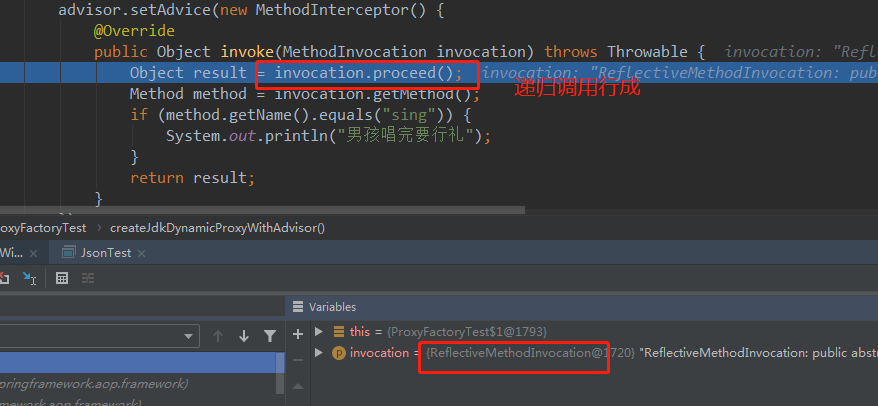
所以,大家看上图就知道了,这里形成了递归调用。
我思考了一下,之所以递归调用,而不是for循环,主要是要保证target的method先执行,执行完了,才能到我们这里的切面来执行。
这样逻辑才对。
当这里递归调用进去时,因为我们只有一个切面,所以就开始执行连接点:
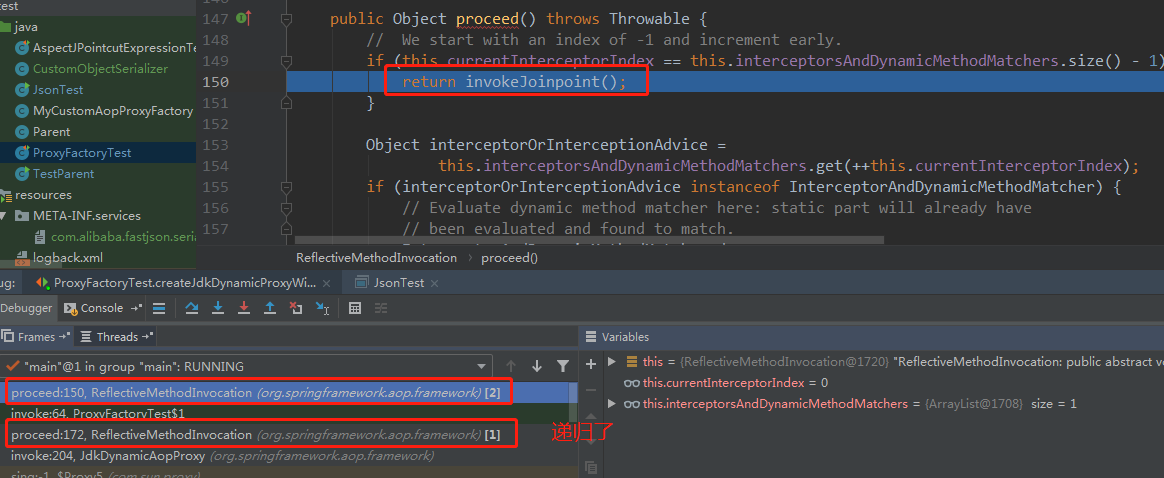
待到连接点执行完了后,会继续执行我们切面的后续逻辑。
这就是和tomcat filter链类似的责任链模式。
总结
aop这块,基本的东西是差不多了,大家有问题及时联系我。
曹工说Spring Boot源码(21)-- 为了让大家理解Spring Aop利器ProxyFactory,我已经拼了的更多相关文章
- 精尽Spring Boot源码分析 - 序言
该系列文章是笔者在学习 Spring Boot 过程中总结下来的,里面涉及到相关源码,可能对读者不太友好,请结合我的源码注释 Spring Boot 源码分析 GitHub 地址 进行阅读 Sprin ...
- 精尽Spring Boot源码分析 - Jar 包的启动实现
该系列文章是笔者在学习 Spring Boot 过程中总结下来的,里面涉及到相关源码,可能对读者不太友好,请结合我的源码注释 Spring Boot 源码分析 GitHub 地址 进行阅读 Sprin ...
- 精尽Spring Boot源码分析 - 文章导读
该系列文章是笔者在学习 Spring Boot 过程中总结下来的,里面涉及到相关源码,可能对读者不太友好,请结合我的源码注释 Spring Boot 源码分析 GitHub 地址 进行阅读 Sprin ...
- 精尽Spring Boot源码分析 - SpringApplication 启动类的启动过程
该系列文章是笔者在学习 Spring Boot 过程中总结下来的,里面涉及到相关源码,可能对读者不太友好,请结合我的源码注释 Spring Boot 源码分析 GitHub 地址 进行阅读 Sprin ...
- 精尽Spring Boot源码分析 - 内嵌Tomcat容器的实现
该系列文章是笔者在学习 Spring Boot 过程中总结下来的,里面涉及到相关源码,可能对读者不太友好,请结合我的源码注释 Spring Boot 源码分析 GitHub 地址 进行阅读 Sprin ...
- 精尽Spring Boot源码分析 - 支持外部 Tomcat 容器的实现
该系列文章是笔者在学习 Spring Boot 过程中总结下来的,里面涉及到相关源码,可能对读者不太友好,请结合我的源码注释 Spring Boot 源码分析 GitHub 地址 进行阅读 Sprin ...
- 精尽Spring Boot源码分析 - 剖析 @SpringBootApplication 注解
该系列文章是笔者在学习 Spring Boot 过程中总结下来的,里面涉及到相关源码,可能对读者不太友好,请结合我的源码注释 Spring Boot 源码分析 GitHub 地址 进行阅读 Sprin ...
- 精尽Spring Boot源码分析 - Condition 接口的扩展
该系列文章是笔者在学习 Spring Boot 过程中总结下来的,里面涉及到相关源码,可能对读者不太友好,请结合我的源码注释 Spring Boot 源码分析 GitHub 地址 进行阅读 Sprin ...
- 精尽Spring Boot源码分析 - 配置加载
该系列文章是笔者在学习 Spring Boot 过程中总结下来的,里面涉及到相关源码,可能对读者不太友好,请结合我的源码注释 Spring Boot 源码分析 GitHub 地址 进行阅读 Sprin ...
- 精尽Spring Boot源码分析 - 日志系统
该系列文章是笔者在学习 Spring Boot 过程中总结下来的,里面涉及到相关源码,可能对读者不太友好,请结合我的源码注释 Spring Boot 源码分析 GitHub 地址 进行阅读 Sprin ...
随机推荐
- org.mybatis.spring.MyBatisSystemException: nested exception is org.apache.ibatis.reflection.ReflectionException: There is no getter for property named 'socialCode' in 'class java.lang.String'
异常: org.mybatis.spring.MyBatisSystemException: nested exception is org.apache.ibatis.reflection.Refl ...
- hm nsis edit请求的操作需要提升
第一次用nsis做安装包,编译运行出现这个问题,解决办法:管理员身份运行即可
- MySQL数据库高可用集群搭建-PXC集群部署
Percona XtraDB Cluster(下文简称PXC集群)提供了MySQL高可用的一种实现方法.集群是有节点组成的,推荐配置至少3个节点,但是也可以运行在2个节点上. PXC原理描述: 分布式 ...
- js中使用EL表达式总结
1.js中使用el表达式要加双引号或单引号:'${list}' 2.js变量获取el表达式中的对象:不能直接获取,直接获取得到的是该对象的toString值. 有两种方法:一:el中直接写对象的属性v ...
- 混合欧拉回路poj 1637 Sightseeing tour
把该图的无向边随便定向,计算每个点的入度和出度.如果有某个点出入度之差为奇数,那么肯定不存在欧拉回路.因为欧拉回路要求每点入度 = 出度,也就是总度数为偶数,存在奇数度点必不能有欧拉回路: 好了,现在 ...
- 62)PHP,提示跳转
由于就是一个普通的页面展示,提示的样式,可以轻松定制! 语法: Header()后的代码会执行,因此在处理好跳转相关操作后,脚本也应该被DIE掉! 案例中实现跳转 封装一个可以完成跳转的方法,需要时, ...
- Mybatis与Spring整合(纯注解)
java1.5版本之后开始支持注解,spring*2开始提供注解配置方式,到spring**4后spring推荐使用注解配置 IOC注解(主要作用就是在spring容器中声明一个Bean,同xml中的 ...
- FPGA浮点数定点数的处理
http://blog.chinaaet.com/justlxy/p/5100053166大佬博客,讲的非常有条理的 1,基础知识 (1)定点数的基础认知: 首先例如一个16位的数表示的定点数的范围是 ...
- java内部类基础知识
一.java内部类具体分四大类 1.成员内部类 2.静态内部类 3.局部内部类 4.匿名内部类 1.成员内部类 :作为类的成员,存在于类中 //成员内部类可以调用外部类的所有 ...
- web前端校招笔试题集锦
写一个求和的函数sum,达到下面的效果 // Should equal 15 sum(1, 2, 3, 4, 5); // Should equal 0 sum(5, null, -5); // Sh ...
